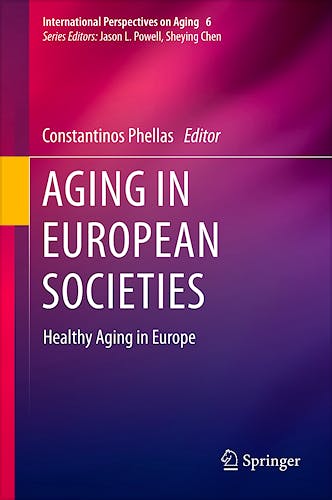

No hay productos en el carrito



Aging in European Societies. Healthy Aging in Europe (International Perspectives on Aging, Vol. 6)
Phellas, C.
1ª Edición Noviembre 2012
Inglés
Tapa dura
285 pags
800 gr
null x null x null cm
ISBN 9781441983442
Editorial SPRINGER
ABOUT THIS BOOK
- Cross-disciplinary roster of expert contributors
- Examples from diverse European societies illustrating innovative methodological approaches to working with diverse elderly populations
The aging of populations is one of the major economic and social developments shaping the 21st century. This timely book aims to integrate our understanding of the changing meanings, representations, and experiences of aging and the key factors shaping them (including behavioral, biological, clinical, cultural, historical, social, economic, and technological), through the eyes and experiences of professionals working in the field of gerontology across Europe. The book is organized in eight major sections intended to cover the whole range of issues concerning extended quality of life among senior European citizens. The objectives are
(1) to stimulate comprehensive discussion on the implications of the most pressing health, social welfare, economic, and other issues related to aging in various European societies,
(2) to attempt to answer the question: how can international and comparative studies of aging contribute to our efforts to understand better the diverse aspects issue on aging,
(3) to generate new knowledge on the aging process and, particularly, the factors contributing to aging well,
(4) to deploy and develop new interdisciplinary perspectives on aging research,
(5) to present examples from diverse European societies that illustrate innovative methodological approaches that would be relevant to professionals working with elderly diverse populations (e.g., ethnic minorities, gay community), and
(6) to contribute to policy, practice, and product development.
Content Level » Research
Keywords » Aging - Aging in Europe - Comparative aging - Demography - European health care - Gerontology - Healthy aging - Population growth - Quality of life - Social policy - Support networks
Related subjects » Population Economics - Population Studies - Public Health - Well-Being
TABLE OF CONTENTS
Part I. Defining and measuring quality of life.
- Managing identity as we age
- Disability within the community
- Focusing social policy on needs and services
- Residential settings and perceived quality of life
- Social networks and living arrangements
- Self-efficacy and independent living
- Religion and spirituality
- Assessing QOL
- The person/environment relationship
Part II. Inequalities in quality of life
- Short- and long-term influences in QOL in early old age
- Associations between SES factors and QOL
- Ethnic inequalities/differences influencing QOL
- Migration
- Residential context
- Social exclusion
- Deprived neighborhoods
- Crime
- Institutional care
Part III. Technology and the built environment
- Use of Information and Communication Technology
- Participating in the self-serve society
- Stimulate and support capacities for such participation (mobility, cognitive)
- Car ownership.- Transport and travel activities in old age
- Older people’s access to, acceptance of, trust in, and use of services provided through ICT-based solutions (health, social, information)
Part IV. Healthy and productive aging
- Cognitive functioning in older people
- Paid employment and psychological well-being
- Well-being differences between unemployment, underemployment, employment, and retirement
- Differences found between social resources of those working and those not working
- Community and voluntary work and psychological well-being
- Reminiscence
- Sexuality
Part V. Family and support networks
- Masculinity and influence on health and social world of older men
- Social activity in later life: variations by gender and class
- Bereavement and gender effects on lifestyle and social participation
- Widowhood and cognitive functioning
- QOL and social support among people from different ethnic background
- Racism
- Loneliness and isolation
- Living alone in later life
- Grandparenthood
- Support networks among elderly gay couples
- Grieving among gay people
Part VI. Participation and activity in later life
- Ethnicity, culture, and aging
- Lifelong learning, learning in retirement; devising accessible, inexpensive, relevant learning opportunities for older people
Part VII. Financial resources for aging
- Constraints and choices faced by relatively wealthy and poor in making pension an savings arrangements
- Factors determining financial plans for later life; impact on recent restructuring of pensions on intergenerational transfers
- Intergenerational cash transfer patterns within different families, across cultures, and between the north and south of the globe
- Technology supplementing formal and informal care
Part VIII. The globalization of aging
- Influence of global economic agencies such as the World Bank on domestic policies in fields such as pensions and long-term care
- Effect of retirement and other types of migration on formation of support networks, community activity, and social interaction
- Effects of cultural policies and norms in countries of origin on immigrants’ well-being in later life
- Living in Diaspora communities
- Social and economic effects of transnationalism for older people in countries of origin and settlement
- Effect of transnationalism on well-being in old age.
© 2025 Axón Librería S.L.
2.149.0